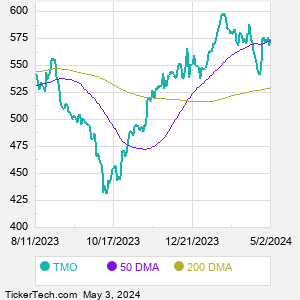Thermo Fisher Scientific is engaged in serving science. Co.'s segments include: Life Sciences Solutions, which provides reagents, instruments and consumables used in biological and medical research, discovery and production of new drugs and vaccines, and diagnosis of disease; Analytical Instruments, which provides instruments, consumables, software and services that are used for a range of applications in the laboratory, on the production line and in the field; and Specialty Diagnostics, which provides diagnostic test kits, reagents, culture media, instruments and associated products; and Laboratory Products and Biopharma Services, which provides virtually things needed for the laboratory.
When researching a stock like Thermo Fisher Scientific, many investors are the most familiar with Fundamental Analysis — looking at a company's balance sheet, earnings, revenues, and what's happening in that company's underlying business. Investors who use Fundamental Analysis to identify good stocks to buy or sell can also benefit from TMO Technical Analysis to help find a good entry or exit point. Technical Analysis is blind to the fundamentals and looks only at the trading data for TMO stock — the real life supply and demand for the stock over time — and examines that data in different ways. One of those ways is to calculate a Simpe Moving Average ("SMA") by looking back a certain number of days. One of the most popular "longer look-backs" is the TMO 200 day moving average ("TMO 200 DMA"), while one of the most popular "shorter look-backs" is the TMO 50 day moving average ("TMO 50 DMA"). A chart showing both of these popular moving averages is shown on this page for Thermo Fisher Scientific. Comparing two moving averages against each other can be a useful visualization tool: by calculating the difference between the TMO 200 DMA and the TMO 50 DMA, we get a moving average convergence divergence indicator ("TMO MACD"). The TMO MACD chart, in conjunction with the chart of the moving averages, basically helps in visualizing how the moving averages are showing convergence (moving closer together), or divergence (moving farther apart). |



